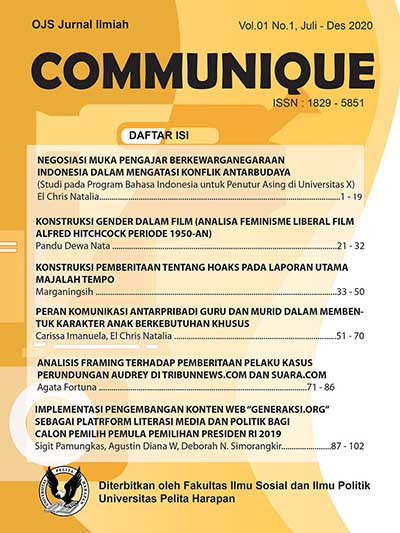NEGOSIASI MUKA PENGAJAR BERKEWARGANEGARAAN INDONESIA DALAM MENGATASI KONFLIK ANTARBUDAYA (Studi pada Program Bahasa Indonesia untuk Penutur Asing di Universitas X) [ADVANCE NEGOTIATION OF INDONESIAN CIVICS TEACHERS IN OVERCOMING INTERCULTURAL CONFLICT (Study in the Indonesian Language Program for Foreign Speakers at X University)]
Kata Kunci:
intercultural communication, cultural conflict, face negotiation, komunikasi antarbudaya, konflik budaya, negosiasi mukaAbstrak
Every individual has different identity and cultural background from other individuals. Regarding culture, face saving is a basic need for someone when interacting with others who have different cultures. In the context of education, especially in the Program Bahasa Indonesia untuk Penutur Asing (BIPA) at University X, teachers who are Indonesian face many students from various countries. The existence of cultural differences does not rule out the possibility of conflict. Face negotiation can be a strategy in overcoming conflicts of cultural differences. This research uses a qualitative descriptive analysis method. In collecting data, this research uses in-depth interview and observation toward two teachers and four students in the BIPA Program as informants. The results showed that in dealing with language and cultural behavior constraints, teachers use different styles of managing conflict, namely dominating and compromising. Teacher who use a dominant style tend to show negative faces, whereas teacher with a compromise style show positive faces. Facework shown here are tact and solidarity facework.
BAHASA INDONESIA ABSTRAK: Setiap individu memiliki identitas dan latar belakang budaya yang berbeda dengan individu lainnya. Terkait dengan budaya, menyelamatkan muka menjadi kebutuhan mendasar bagi tiap individu ketika berinteraksi dengan orang lain, khususnya saat individu menghadapi budaya yang berbeda. Pada konteks pendidikan, khususnya di Program Bahasa Indonesia untuk Penutur Asing (BIPA) di Universitas X, staf pengajar yang adalah orang berkewarganegaraan Indonesia menghadapi banyak peserta yang berasal dari berbagai negara. Dengan adanya perbedaan budaya tidak menutup kemungkinan terjadinya konflik. Negosiasi muka dapat menjadi strategi dalam mengatasi konflik perbedaan budaya. Penelitian ini menggunakan pendekatan kualitatif dengan metode analisis deskriptif. Peneliti melakukan observasi dan wawancara mendalam dengan dua staf pengajar dan empat peserta di program BIPA sebagai informan. Hasil penelitian menunjukkan bahwa dalam menghadapi kendala bahasa dan perilaku budaya, dua pengajar menunjukkan gaya menangani konflik yang berbeda, yaitu mendominasi dan kompromi. Pengajar yang menggunakan gaya mendominasi cenderung menunjukkan muka negatif, sedangkan pengajar dengan gaya kompromi menunjukkan muka positif. Facework yang ditunjukkan adalah tact facework dan solidarity facework.
Referensi
BIPA Universitas X. (n.d.). Retrieved from https://lbifib.ux.ac.id/archives/category/bipa/about-bipa/regular-program
Darmastuti, R. (2013). Mindfullness dalam Komunikasi Antarbudaya. Yogyakarta, Indonesia: Buku Litera.
Griffin, E. (2012). A First Look at Communication Theory. New York: McGraw-Hill.
Gudykunst, W. B., & Kim, Y. (2003). Communicating with Strangers (4th ed.). New York: McGraw-Hill.
Gudykunst, W. B., & Mody, B. (2002). Handbook of International and Intercultural Communication. New York: Sage.
Hidayat, D. (2014). Social and Cultural Identity Pendekatan Face Negotation Theory dan Public Relations Multikulturalism Negara Jerman-China dan Indonesia. Jurnal ASPIKOM, 2(2), 115-126. https://doi.org/10.24329/aspikom.v2i2.64
Jandt, F. E. (2007). An Introduction to Intercultural Communication: Identities in a Global Community (5th ed.). Thousand Oaks, CA: Sage.
Martin, J. N., & Nakayama, T. (2007). Intercultural Communication in Contexts (4th ed.). New York: McGraw-Hill.
Nassaji, H. (2015). Qualitative and descriptive. Language Teaching Research, 19(2), 129-132. https://doi.org/10.1177/1362168815572747
Ruben, B. D., & Stewart, L. (2006). Communication and Human Behaviour (5th ed.). Boston, MA: Pearson Education, Inc.
Samovar, L. A., Porter, R., McDaniel, E., & Roy, C. (2013). Communication between Cultures (8th ed.). Boston, MA: Wadsworth.
West, R., & Turner, L. (2014). Introducing Communication Theory: Analysis and Application, International Edition. New York: McGraw-Hill.
Yuliati, R. (2014). Perilaku Penyelamatan Muka Pada Sosial Media. SEMINAR NASIONAL TEKNOLOGI INFORMASI & KOMUNIKASI TERAPAN (SEMANTIK) , 41-46.
Unduhan
Diterbitkan
Terbitan
Bagian
Lisensi
Authors who publish with this journal agree to the following terms:
1) Authors retain copyright and grant the journal right of first publication with the work simultaneously licensed under a Creative Commons Attribution License (CC-BY-SA 4.0) that allows others to share the work with an acknowledgement of the work's authorship and initial publication in this journal.
2) Authors are able to enter into separate, additional contractual arrangements for the non-exclusive distribution of the journal's published version of the work (e.g., post it to an institutional repository or publish it in a book), with an acknowledgement of its initial publication in this journal.
3) Authors are permitted and encouraged to post their work online (e.g., in institutional repositories or on their website). The final published PDF should be used and bibliographic details that credit the publication in this journal should be included.

